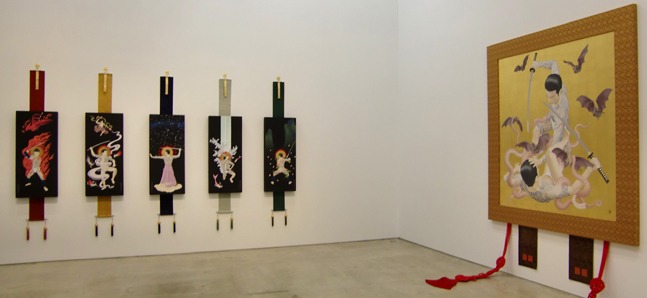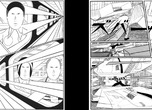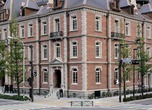
Courtesy of Mizuma Art Gallery: installation view "FURYU-EXTRAVAGANT" 2009-2010, TENMYOUYA Hisashi
Posted: Wed Jan 27 2010
The Tokyo gallery scene is forever in flux, making it both frustratingly elusive and perfectly illustrative of the city itself. Whether it be the cause of a short-term lease, the city’s own predilection towards reinvention, or an ambition to grow, galleries are known to pick up and move at a dizzying rate. Never mind the challenge for critics and publishers to commit to print a definitive Tokyo art map, the shuffling poses a different concern for the galleries— surviving a new location.
As Tokyo boasts no cohesive art district, gallery-going is often appended in short doses to one’s daily routine (or ramblings), rather than a comprehensive (and exhausting) day in and of itself. This could mean that art lovers tend to frequent those spaces whose paths they often cross. On the other hand, the scattered nature of Tokyo’s galleries can also serve as inspiration to seek out an otherwise unexplored quarter of the city.
Vacant
For better or for worse, art and fashion go hand in hand during this current reigning age of the collaboration, and shopping districts like Ginza and Aoyama abound with branded gallery spaces. Harajuku and Omotesando are in on the trend too (see exhibition spaces at Omotesando Hills, Gyre, and LaForet), which makes independent gallery and event space Vacant a welcome— bordering on imperative —addition to the neighbourhood. Event planning organization No Idea opened the surprisingly airy space in May of 2009. Their reason for making Vacant a gallery, rather than simply an event venue, was to position art as a starting point for human encounters and idea exchange. ‘From that point of view, the mission of Vacant is to make art a greater part of the fabric of everyday life,’ says Yusuke Nagai of No Idea. The backstreet Harajuku venue has hosted events such as the DIY magazine fair Zinesmate and the Post-mainstream Performance Festival. Unlike most Tokyo galleries, Vacant remains open even between exhibitions and serves drinks, so to be accompanied by food. This, along with later opening hours, conspires to make the gallery a regular hangout.
Address: 3-20-13 Jingumae, Shibuya, Tokyo
Telephone: (03)6459 2962
Open: Tues-Sun 1pm-10pm
Website: www.n0idea.com/
Nanzuka Underground
Since its 2005 debut in a Shibuya basement, Nanzuka Underground has been more closely affiliated with street culture and the Tokyo club scene than the art world, hence the Shibuya location and the reputation for lively openings. More than just a reference to its original subterranean location, the ‘underground’ in the name hints at owner Shinji Nanzuka’s practice of selecting artists based on their originality— their ability to ‘symbolize the times and even go beyond’ —rather than their fine art credentials. In April 2009 the gallery relocated to the recently renovated Shirokane Art Complex. The move positioned Nanzuka Underground as less of an art industry outsider, though Nanzuka laments feeling removed from the ‘young with their flexible and unlimited viewpoints’ in Shibuya. The Shirokane Art Complex does, however, offer visitors a 3-in-1, with contemporary galleries Yamamoto Gendai and Kodama all in the same building.
Address: Shirokane Art Complex #2F, 3-1-15 Shirokane, Minato, Tokyo
Telephone: (03)6459 3130
Open: Tues-Sat 11am-7pm; closed nat. holidays
Website: nug.jp/
Mizuma Art Gallery
Owner Sueo Mizuma has an eye for strong Japanese artists with their roots intact. Though they should have a ‘conceptual edge,’ he says, rather than employ their Japanese-ness to appeal to overseas audiences. The artists he has assembled are in fact an eclectic bunch; recent exhibitions have included the photo-real tapestries of Satoru Aoyama, the organic, shifting naphthalene sculptures of Aiko Miyanagi, and the gilt ‘neo nihonga’ of Hisashi Tenmyouya. Mizuma Art Gallery, which has been operating out of a wonderfully derelict space in Nakameguro since 2002, has been particularly active recently, appearing at art fairs from Miami to Busan. Itchy feet (or rather a building set to be demolished) saw the gallery open a new space in Ichigaya in November 2009. It makes up for its less than convenient location with six meter high ceilings suited for ‘epic installations,’ Mizuma notes, hinting at what might be in store. The beloved (and admittedly totally deteriorating) Nakameguro venue, meanwhile, will continue to run until 2011 as Mizuma Action, an exhibition space for younger, less established creators.
Address: Kagura Bldg. 2F, 3-13 Ichigayatamachi Shinjuku, Tokyo
Telephone: (03)3268 2500
Open: Tues-Sat 11am-7pm; closed on Sun, Mon and nat. holidays
Website: mizuma-art.co.jp/
Nakameguro Branch (See full details & map]
Aoyama | Meguro
Up the road from Mizuma Action is a street gallery in the literal sense: Aoyama | Meguro is fronted with glass panels that afford passersby a clear view of the exhibition and office spaces inside. Hideki Aoyama, who began running Aoyama | Meguro out of his apartment in 2004, moved into this current Nakameguro space in the summer of 2007. The gallery shares the rough, loft-like space (a former delivery company’s office) with the progressive architecture firm Sschemata. Operating under the collective name ‘happa,’ the two show alternate— and occasionally joint —exhibitions. Aoyama, who actually worked at Mizuma Art Gallery for several years, says he looks for artists with ‘an abundance of ideas’ and as a result the exhibitions at Aoyama | Meguro tend to be conceptual. Keep an eye out for exhibitions from regulars Koki Tanaka, Junya Sato and Lyon Lotte. Aoyama | Meguro is also one of the founding members of the New Tokyo Contemporaries, a group of seven galleries that have opened since 2004.
Address: 2-30-6 Kamimeguro, Meguro, Tokyo
Telephone: (03)3711 4099
Open: Mon-Sat 11am-7pm; closed on Sun and nat. holidays
Website: www.aoyamahideki.com/
Take Ninagawa
Falling roughly inside Art Triangle Roppongi, a space coined by the Mori Art Museum, Suntory Museum, and the National Art Center, Take Ninagawa enjoys a proximity to some of the city’s most frequented art institutions. Its quiet, side street location, however, hardly suggests that both the brash Roppongi and upscale Azabu Juban are within walking distance. This ambitious, energetic young gallery, run by Atsuko Ninagawa, has appeared regularly at NADA art fair in Miami and a host of domestic fairs since opening in late 2007. Along with its line up of young Japanese artists, including the colourful, playful Misaki Kawai, Take Ninagawa began showing new works from Shinro Ohtake in 2008. Though hardly up-and-coming (being a rather established art world figure), Ohtake has grabbed headlines recently for designing a bathhouse that also functions as a radical art installation in Naoshima (the “I♥湯” project). Take Ninagawa is also a founding member of New Tokyo Contemporaries, along with Aoyama | Meguro, Arataniurano, Zenshi, Misako & Rosen, Mujin-to Productions, and Yuka Sasahara Gallery.
Address: 2-12-4 Higashi-Azabu, Minato, Tokyo
Telephone: (03)5571 5844
Open: Tues-Sat 11am-7pm; closed nat. holidays
Website: www.takeninagawa.com/
While galleries come and go (both in fashion and in physical location), the Kiyosumi Shirokawa complex remains the most consistent, not to mention efficient, place to see contemporary art in Tokyo. The influential Tomio Koyama Gallery fills up the 7th and half the 6th floor of this shipping warehouse and handles such well-known Japanese art figures like Yoshitomo Nara and Mika Ninagawa. The Taka Ishii Gallery, whose artists include the photographers Daido Moriyama and Nobuyoshi Araki, plus the recommendable ShugoArts and Hiromi Yoshii galleries are also located here. Meanwhile, more Tomio Koyama Gallery love, in the form of covetable art goods, can be found at the TKG Editions shop in Ginza.
TKG Editions
Address: 1-22-13 Ginza, Chuo, Tokyo
Telephone: (03)5250 1561
Open: Tues-Sat 11:30am-7pm; closed Sun, Mon and nat. holidays
Website: www.tomiokoyamagallery.com/tkgeabout_en/
Related articles
・Noguchi’s geometric zoo
Time Out Café & Diner hosts young artist’s solo menagerie show
・Tokyo’s independent book shops
Five of the city’s most innovative booksellers
・TOT Video : Nick Walker paints
Time Out Tokyo catches British street artist in the act
Tags:
Tweets
- About Us |
- Work for Time Out |
- Send us info |
- Advertising |
- Mobile edition |
- Terms & Conditions |
- Privacy policy |
- Contact Us
Copyright © 2014 Time Out Tokyo













Add your comment